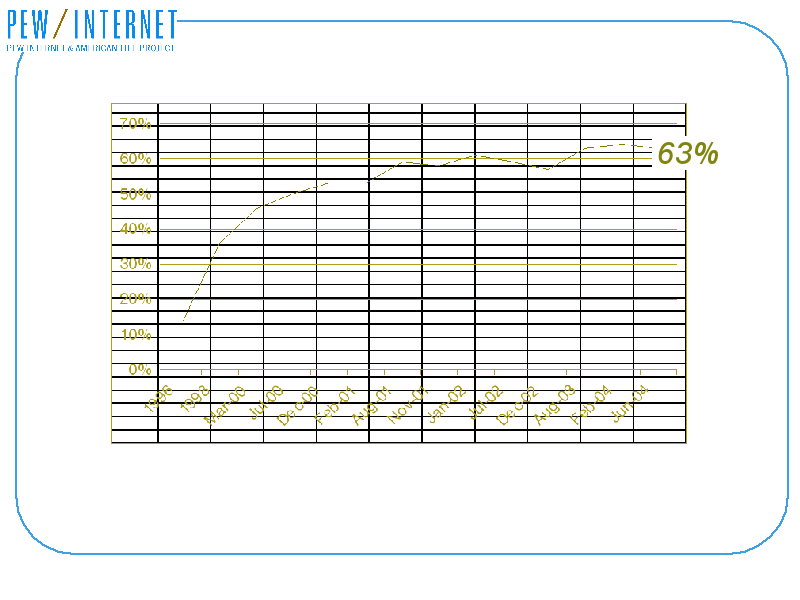Impact on Society and Culture
Daniel Weitzner
W3C Tenth Anniversary
1 Dec 2004
Impact on Society and Culture
Lee Rainie, Director PIP
Moderator: Daniel J. Weitzner (W3C)
Has the Web lived up to its promise?
"The Internet is 'a unique and wholly new medium of
worldwide human communication.'"
ACLU v. Reno, United States Supreme Court (June 1997)
"The Internet is a far more speech-enhancing medium than print, the village green, or the mails.... The Internet may fairly be regarded as a never-ending worldwide conversation."
ALA v US Department of Justice, United States District Court for the Eastern District of Pennsylvania, Judge Stewart Dalzell (June 1996)
Balkanization of viewpoints -- the Web as self-enforcing echo chamber
"In 1996, political speech on the Web exhibited a rich diversity of perspectives and formats. Political speakers, however, tended to discourage public debate by refusing to provide links to opposing viewpoints....The data presents a bleak vision of democratic discourse on the Web. [O]nly a small minority of partisan sites ... offered links to opposing viewpoints"
A. Chin, Making the World Wide Web Safe for Democracy, 19 Hastings Communications & Entertainment Law Journal 309 (1997).
The Adoption of the Internet and its Impact

Lee Rainie, Director PIP
Lrainie@pewinternet.org
Being online is the norm...
...but it is not universal.

Broadband adoption

Typical day online
Proportion of those online doing various activities.

What teenagers do online — informal use

What teenagers do online — educational use

The Internet helps in everyday life
Percentage of Internet users who say their use of the Internet improves
their access to/experience of ...

The Internet helps at major life moments
Percentage of Internet users who went through these activities recently
and say their use of the Internet was critically important or very important
when they were dealing with ...

The Internet and health
What e-patients do — 1
- Tentatively diagnose their own diseases
- Confirm their doctor's diagnosis and suggested treatments
- Check their doctors' credentials
- Research all available treatment options, not just those
recommended by doctor
What e-patients do — 2
102 million Americans are online health seekers. This is the material they
access:

The Internet and religious and spiritual life
The e-faith universe = 82 million Americans
- 58 million have sought information online about their own faith.
- 51 million have sought information online about others' faiths.
- 48 million have used email for spiritual/religious discussion
- 45 million sent religiously-oriented greeting cards
- 41 million read news about religious events
- 27 million sought information about how to celebrate holidays or other
religious events
- 22 million have looked for places to attend church
- 19 million say they belong to online
religious communities
- 18 million have used email to plan a meeting for a religious group
- 12 million have participated in online
activities of their local church
- 11 million have downloaded religious music or listened to it online
- 10 million have done devotional work
online
- 9 million have made donations to religious organizations
- 8 million have purchased religious goods and services
- 6 million have participated in online worship
The Internet and government and politics
The e-citizen nation
- 83 million use government Web sites
- 56 million used the Internet for the 2004 political campaign
- 52 million use the Internet to research policy issues
- 38 million have sent email to government officials to try to affect
change in policies
- 36 million use government Web sites for health and safety issues
- 29 million researched or applied for government benefits
- 27 million said the Internet was important source of political
information to them
- 24 million participated in organized lobbying campaigns
- 9 million said Internet information helped decide their vote in
2000
What Internet users do on government sites
- 66% look for general information from federal, state, or local
sites
- 41% research official documents/statistics
- 34% get recreational/tourist information
- 30% have used the Internet to try to change a government policy or
affect a vote on a law
- 28% have gotten advice about a health or safety issue from a government
agency
- 27% have sent emails to government
- 23% get information about or apply for benefits
The Internet and community
Internet communities
84% of Internet users belong to online groups. The groups they belong
to:
| Trade association or professional group |
50% |
| A group for people who share hobby or interest |
50 |
| A fan group of a particular team |
31 |
| A fan group of a TV show or entertainer |
29 |
| A local community group or association |
29 |
| A group of people who share your lifestyle |
28 |
| A support group for a medical condition or personal problem |
28 |
| A group of people who share your beliefs |
24 |
| A political group |
22 |
| A religious organization |
21 |
| A sports team or league in which you participate |
29 |
| Ethnic or cultural group |
15 |
| Labor union |
6 |
Source: Pew Internet & American Life Project, Jan-Feb 2001
Survey,
Internet users, n=1697. Margin of error is +/- 3%.
Digital divide 1: Age

Digital divide 2: Household income

Digital divide 3: Educational attainment

Digital divide 4: Race and ethnicity (English speaking)

Digital divide 5: Community type

Digital divide 6: Disability

Digital divide 7: Disability
- Hope
- Those with high levels of hope or 60% more likely to be online
- Trust
- People can be trusted: 43% more likely to be online
- Government can be trusted: 35% more likely to be online
- Self-efficacy (I can control my destiny)
- 63% more likely to be online
Next Session
After lunch there will be Recognitions and
Proclamations.
All W3C10 Sessions















